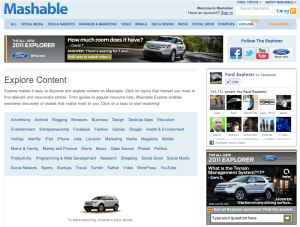When I started my digital marketing career in 1996, I was lucky enough to work for a company who was run by visionaries. The company was Modem Media, and one of the founders was a guy named GM O’Connell (well, he’s still named that!). One of the many things I learned from him was the idea that digital made possible the idea of “advertising as a service” and it seems that many brands are finally starting to figure out what that means now here in 2011, 15 years later.
How did Modem Media define “Advertising as a Service”? It’s advertising so useful that you are compelled to engage with it and in so doing, achieve the brands marketing objectives, whether brand awareness or lead generation, or real time customer service leading to loyalty. That said, GM’s take today is that AaaS has become all the more important and available to brands as Web Services and APIs continue to proliferate. Google Maps’ API being leveraged in a brand’s “store locator” is great advertising for Google as a whole, and all because they created a service and had it distributed to where it was most useful. Same as when you can track your package on a retailer’s website: great advertising for FedEx or UPS.
To quote GM O’Connell: “The idea of advertising as a service cam out of the fact that people back then (and probably still) don’t read or watch the web as much as they use it, and if you don’t create “useful” advertising, then it will tend to be out of place and ignored. the problem is that useful advertising (or advertising so good people will embrace it as a service) can’t really ask for an immediate sale. It has to serve the customer, create good will, help the customer figure something out or otherwise create this new notion of engagement through (most likely but not always) utility”
Bob Allen, past president of Modem says “AaaS can also be thought of as branded planning tools–living, breathing ads that allow people to interact with the brand, solve problems, etc” He suggests that the proliferation of apps today represents some of the best of Advertising as a Service, and for brands like Best Buy, this is certainly true. Unfortunately, many branded apps are lost in the hundreds of thousands of apps available.
Lots of brands of course figured it out years ago, but the idea that advertising could provide more than just message delivery is something that you still don’t see enough of. Instead what you see are more online interpretations of “above-the-line”, traditional advertising brought to life in online venues. What this results in are click through rates well below 1% and engagement rates with even rich media advertising that is only slightly higher.
So what does “advertising as a service” look like? The earliest memory of it that I have was work done by Modem Media in 1997 when it launched the first rich media banners for John Hancock insurance. It used HTML pull down menus to allow users to choose their income level and retirement year and the take them to a landing page which provided personalized recommendations and next steps. It was genius and got a 24% click through rate, unheard of today.
 The John Hancock example was right for 1997, as everyone who was online was looking for cool things to do online, and is an example of tactics common place today and no longer as engaging as it was then. However, when looking for examples of “Advertising as a Service” today, you typically have to look well beyond the banner to find it. For instance, I ran across this page on Mashable, pictured here, that they’ve created in partnership with Ford. It’s a predefined search index that helps build the idea of the Ford Explorer as a brand that can help you get places. The bet part is is that the banners that surround it are really service oriented, allowing you to ask questions and view videos of the product. The Mashable “explore” feature itself is pure service, and the two together make a nice package of worthwhile engagement for the user.
The John Hancock example was right for 1997, as everyone who was online was looking for cool things to do online, and is an example of tactics common place today and no longer as engaging as it was then. However, when looking for examples of “Advertising as a Service” today, you typically have to look well beyond the banner to find it. For instance, I ran across this page on Mashable, pictured here, that they’ve created in partnership with Ford. It’s a predefined search index that helps build the idea of the Ford Explorer as a brand that can help you get places. The bet part is is that the banners that surround it are really service oriented, allowing you to ask questions and view videos of the product. The Mashable “explore” feature itself is pure service, and the two together make a nice package of worthwhile engagement for the user.
Ford isn’t the only example, other brand who are excelling at this approach include technology companies, banks, car manufacturers, airlines, and even a few CPG companies who have put ecoupons right in their advertising banners. And beyond the banner, the best branded apps take Advertising as a Service to a whole new level. You just don’t see it as much as you should.
The question to ask is; why aren’t more brands putting forth “Advertising as a Service”? Do they not have anything interesting to engage users with? you’d think with Behavioral Targeting available today that you’d see nothing but advertising that speaks to the users needs directly.
Feedback is welcome in the comments section below.
